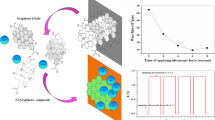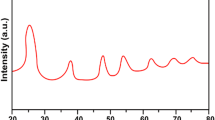Abstract
Ball milling was used to prepare nanocrystalline TiO2, GO and PVDF-HFP/TiO2/GO nanocomposite, and the effects of milling hours on phase transformation and crystal size wasinvestigated. The films were made using the doctor blade method. XRD, SEM, FTIR spectra were used to characterize the prepared samples. The dielectric constant values were calculated for different milling hour. A lightweight, low-power film is described here for controlling the engagement in a mobile cleaning device. Electrostatic adhesion between thin electrode sheets covered with a dielectric substance underpins the film. The load bearing is influenced by the GO to TiO2 wt.%. A portable device has been fabricated based on the concept of electroadhesion.









Similar content being viewed by others
Data Availability
The data will be available from the authors upon request.
References
A. Rastogi and R. Manohar, Effect of graphene oxide dispersion in nematic mesogen and their characterization results. Appl. Phys. A 125, 192 (2019).
K. Deshmukh and M. Joshi, Thermo-mechanical properties of poly (vinyl chloride)/graphene oxide as high performance nanocomposites. Polym. Test 34, 211–219 (2014).
K. Deshmukh, M. Ahamed, R. Deshmukh, S.K. Pasha, K. Sadasivuni, D. Ponnamma, and K. Chidambaram, Synergistic effect of vanadium pentoxide and graphene oxide in polyvinyl alcohol for energy storage application. Eur. Polym. J 76, 14–27 (2016).
A.B. Bourlinos, D. Gournis, D. Petridis, T. Szabo, A. Szeri, and I. Dekany, Graphite oxide: chemical reduction to graphite and surface modification with primary aliphatic amines and amino acids. Langmuir 19, 6050–6055 (2003).
K. Deshmukh, M. Ahamed, S.K. Pasha, R. Deshmukh, and R. Bhagat, Highly dispersible graphene oxide reinforced polypyrrole/polyvinyl alcohol blend nanocomposites with high dielectric constant and low dielectric loss. RSC Adv. 5, 61933–61945 (2015).
K. Deshmukh, M.B. Ahamed, R. Deshmukh, S.K. Pasha, K. Chidambaram, K. Sadasivuni, D. Ponnamma, and M.A. AlMaadeed, Eco-friendly synthesis of graphene oxide reinforced hydroxypropyl methylcellulose/polyvinyl alcohol blend nanocomposites filled with zinc oxide nanoparticles for high-k capacitor applications. PolymPlast Technol. Eng. 55, 1240–1253 (2016).
S. Andersson, B. Collen, U. Kuylenstierna, and A. Magneli, Phase analysis studies on the titanium oxygen system. Acta Chem. Scand. 11, 1641 (1957).
J.S. Anderson and B.G. Hyde, On the possible role of dislocations in generating ordered and disordered shear structures. J. Phys. Chem. Solids 28, 1393 (1967).
E. Wierzbicka, M. Domaschke, N. Denisov, D. Fehn, I. Hwang, M. Kaufmann, B. Kunstmann, J. Schmidt, K. Meyer, W. Peukert, and P. Schmuki, Magnéli phases doped with Pt for photocatalytic hydrogen evolution. ACS Appl. Energy Mater. 2, 8399–8404 (2019).
R. Liu, L. Pan, X. Liu, and D. Wu, An evaporation-induced tri-constituent assembly approach to fabricate an ordered mesoporous carbon/graphene aerogel for high-performance supercapacitors. RSC Adv. 5, 16765–16768 (2015).
Y. Liang, H. Wang, H. Casalongue, Z. Chen, and H. Dai, TiO2 nanocrystals grown on graphene as advancedphotocatalytic hybrid materials. Nano Res. 3, 701–705 (2010).
G. Peng, X. Zhao, Z. Zhan, S. Ci, Q. Wang, Y. Liang, and M. Zhao, New crystal structure and discharge efficiency ofpoly(vinylidene fluoride-hexafluoropropylene)/poly(methyl methacrylate) blend films. RSC Adv. 4, 16849 (2014).
S. Conze, I. Veremchuk, M. Reibold, B. Matthey, A. Michaelis, I. Yu Grin, and Kinski, “Magnéli phases Ti4O7 and Ti8O15 and their carbon nanocomposites via the thermal decomposition-precursor route. J. Solid State Chem. 229, 235–242 (2015).
S. Harada, K. Tanaka, and H. Inui, Thermoelectric properties and crystallographic shear structures in titanium oxides of the Magnèliphases. J. Appl. Phys. 108, 083703 (2010).
A. Rastogi, and R. Manohar, Effect of graphene oxide dispersion in nematic mesogen and theircharacterization results. Appl. Phys. A. 125, 192 (2019).
A. Wypych, I. Bobowska, M. Tracz, A. Opasinska, S. Kadlubowski, A. Krzywania-Kaliszewska, J. Grobelny, and P. Wojciechowski, Dielectric properties and characterisation of titanium dioxide obtained by different chemistry methods. J. Nanomater. 124814, 9 (2014).
W. Tong, Y. Zhang, L. Yu, F. Lv, L. Liu, Q. Zhang, and Q. An, Amorphous TiO2-coated reduced graphene oxide hybridnanostructures for polymer composites with low dielectric loss. Chem. Phys. Lett. 638, 43–46 (2015).
K. Deshmukh, M. Ahamed, R. Deshmukh, S.K. Pasha, K. Sadasivuni, D. Ponnamma, and M. AlMaadeed, Striking multiple synergies in novel three-phase fluoropolymernanocomposites by combining titanium dioxide and grapheneoxide as hybrid fillers. J. Mater. Sci. Mater. Electron. 28, 559–575 (2017).
J. Wang, Z. Shi, X. Wang, X. Mai, R. Fan, H. Liu, X. Wang, and Z. Guo, Enhancing dielectric performance of poly(vinylidene fluoride) nanocomposites viacontrolled distribution of carbon nanotubes and barium titanate nanoparticles. Eng. Sci. 4, 79–86 (2018).
M. Selvaraj, R. Senthilkumar, R. Balaji, S. Selvasekarapandian, and G. Manivasagam , Influence of graphene oxide and reduced graphene oxide on dielectric properties of PZT/PVDF composite films, in AIP Conf. Proc. 2162, 020056-1–020056-7 (2019)
Y.C. Li, S.C. Tjong, and R.K.Y. Li, Electrical conductivity and dielectric response of poly(vinylidene fluoride)–graphite nanoplatelet composites. Synth. Met. 160, 17–18, 1912–19191919 (2010).
L.J. Ramasanta, M. Hernandez, M.A. Lopez-Manchaob, and R. Verdejo, Functionalised graphene sheets as effective high dielectric constant fillers. Nanoscale. Res. Lett. 6, 508–513 (2011).
N. Ibrayev, A. Zhumabekov, S. Ghyngazov, and E. Lysenko, Synthesis and study of the properties of nanocomposite materials TiO2-GO and TiO2-rGO. Mater. Res. Express 6, 125036 (2019).
Author information
Authors and Affiliations
Corresponding author
Ethics declarations
Conflict of interest
The authors declare no conflict of interest.
Additional information
Publisher's Note
Springer Nature remains neutral with regard to jurisdictional claims in published maps and institutional affiliations.
Rights and permissions
Springer Nature or its licensor (e.g. a society or other partner) holds exclusive rights to this article under a publishing agreement with the author(s) or other rightsholder(s); author self-archiving of the accepted manuscript version of this article is solely governed by the terms of such publishing agreement and applicable law.
About this article
Cite this article
Deepak Rosario, J., Ranjithkumar, R., Vidhya, B. et al. Influence of GO Concentration in Development of PVDF-HFP/TiO2/Graphene Oxide Nanocomposite Films for Electroadhesive Applications. J. Electron. Mater. 52, 2062–2070 (2023). https://doi.org/10.1007/s11664-022-10138-3
Received:
Accepted:
Published:
Issue Date:
DOI: https://doi.org/10.1007/s11664-022-10138-3




